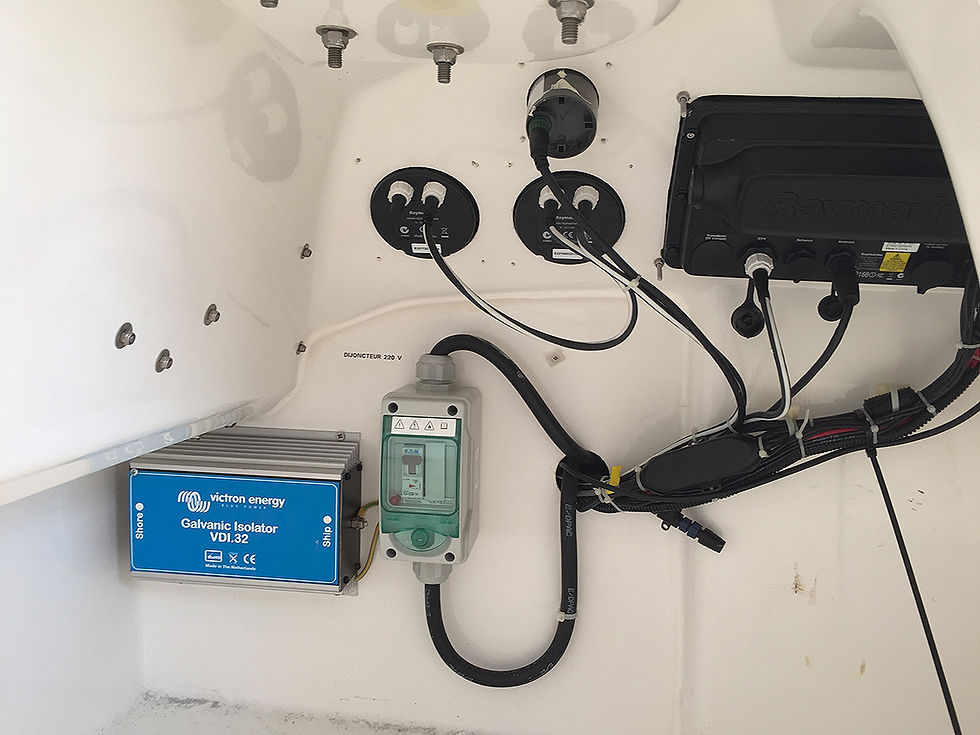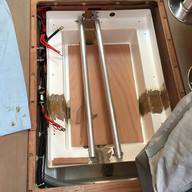Replacing the batteries and running 220/240v full time
- Sailing The Dream

- Aug 18, 2017
- 6 min read
Updated: Oct 24, 2022
Well, this story starts way back when we purchased our yacht late in 2016.
The first signs of the problem, however, occurred during our shakedown sail, March 2017 with systems failing and a complete reboot mid-ocean voyage.
All it took was one touch on the electric winch after we had issues with the fuel tanks that stopped us from using the engine and the whole boat's electronics died. We figured out that there was a good chance our batteries had fully discharged or something was not correctly wired.
We confirmed our suspicions regarding the batteries with a check-up done by the boatyard shortly after our return to Lisbon after our five-day shakedown sail to Gibraltar. At the same time, we also found our propeller had dissolved the anodes from new in just those few days.
Luckily we had made the decision of not leaving the yacht in the water while we were still sorting our lives in Macau, otherwise, we would have continued damaging the underwater components.
Later, while we were still in the boatyard we found another problem that we think was originated with the batteries fail. This was a critical problem also and implicated the replacement of our rudder bearing.
Our one disappointment from our survey was that this was not checked by the surveyor.
The yacht original batteries were 4 x 140Ah Excide Heavy Duty Wet Cell batteries and were just on 4 years old, we believe they were left on charge with a Cristec charger for long periods of time, we noted that the yacht was rarely used prior to our purchase and the batteries seemed not to have been checked for levels of distilled water EVER.
With the confirmation of the battery bank condition as an excuse, we decided that we needed to think exactly how we wanted our lives aboard to be. After all, we could simply replace the dead batteries with another set of similar ones and consider the problem solved, and save us a lot of money.
But we wanted to live comfortably, with some commodities and with some reassurance that the battery bank was capable enough to sustain the needs of liveaboards.
We wanted to be able to run the 220/240v system off the batteries.
That was the goal, to be able to use our coffee machine, the microwave, the kitchen robot, charge our devices, etc even if with some limitations.
We looked at all the options of batteries and charging systems, including the new generation batteries using Lithium-ion technology but decided that the current cost for these is still 3 to 4 times of what we consider affordable and justifiable. We believe this technology will become more affordable and maybe even newer solutions will become available in the future when we need to do another replacement. (i.e.i Lithium Dry Cell looks interesting as potential emerging technology)
Having ruled out the Lithium-ion off the equation we decided we wanted a holistic system and we felt there were only two complete systems to choose from, Mastervolt or Victron Energy.
In the end, we went with Victron Energy believing their product was more robust and better supported for our needs anyway, but also because of the support we got from them through their Sales Manager for the entire Southern Europe and Northern Africa, Richard IJzelendoorn that pointed us to one of their certified consultants in Portugal, Zagalo Yacht Consulting (aka Afonso), and put us also in contact with their local representative for nautical products Enernaval SA (aka Diana) who assisted us brilliantly!
We consulted heavily with Victron Energy and originally we had selected the Deep Cycle GEL batteries, but when the time of actually placing the order they advised us they were launching a new product that was more suited to our needs and with better performance so we ended up changing our selection to 4 x Victron Energy 230Ah AGM Super Cycle batteries giving us over double the previous battery capacity now at 920Ah.
The special thing about these batteries is that it is possible to fully discharge them a few times and recover them without damage to the batteries.
Now that we had ordered the new batteries, the fun part began!
We had a few days to prepare for the installation and a lot of work to do since the battery bank is located under the floor in the centre of the saloon inside a battery box/tray and the new batteries were not the same size as the original ones. We decided to rebuild the battery box/tray to fit the new batteries and reinforce the bottom of the box to accommodate the excess weight of the bigger batteries (whilst not strictly required with a sealed gel battery we decided to keep the box idea to provide further isolation of the batteries from water exposure given their location despite the bilge being so deep).
We cut the box in both directions and resized it re-building with fibreglass and reinforcing the base with aluminium square bars and a ply insert to handle the additional weight. We also replaced the hold down bars with new longer ones and stainless steel bolts.

We picked up the batteries from the Victron Energy shop in Cascais Marina and at 61kg each the car really struggled with the four of them in the boot, I don’t think the mother in law would have approved the use of the car.
Lifting them to the boat that was on hardstand was also an interesting adventure.

With Afonso (Victron Energy consultant) guidance we selected a high power charger inverter, the MultiPlus 12/3000/120 also by Victron Energy, giving us plenty of charging amps and a big inverter to run all appliances on board including the microwave, washing machine, kitchen robot and most importantly the coffee machine (got to keep the girl happy) from the battery bank.
We note that the MultiPlus will also support any future battery upgrades even if getting Lithium-ion ones. It may need though to get a software update from Victron Energy to accommodate new technologies.
The ability to run the 220/240v system off the batteries was what pushed our decisions, although this needs to be done with care and attention to what is plugged in and being used at any time before turning any other appliance even when the battery bank is at 100% charge.
We have a few “house rules” to be followed at all times:
1 kitchen appliance at a time and ideally only when the battery bank is at 100%
small items such as iPhone, iPad, toothbrush and camera chargers can be plugged at any time but ideally only during the day
the heater CANNOT be plugged into the general 220/240v system ever (needs to be plugged in a specific plug that only works when connected to shore power)
the washing machine can only be run at minimal a temperature (30ºC-40ºC) and lower speed spin cycles
The installation was reasonably straightforward since the original wiring system was quite comprehensive, so with some additions and upgrades between the MultiPlus and the battery bank we were able to reuse most of the existing 12v cabling.
Since we were looking deeply into our electrical system and we had identified a problem in our propeller, when we hauled out after the shakedown sail, related to electrolysis corrosion we decided we needed to improve our earthing isolation. We installed a Victron Energy Galvanic Isolator VDI - 32 on our shore power connection to ensure we are protected from any potential flaws in marina shore power and earthing systems.
With Afonsos assistance, we performed an earthing loop test at the marina and ensured that the galvanic isolator was working and that no stray currents were present.

We monitor the whole system with a Victron Energy Precision Battery Monitor and a Color Control GX display for easy checking of inputs and outputs from the system including the solar system.

We are always concerned about galvanic corrosion of underwater components of the yacht and for the most part, we try not to connect to shore power for long periods of time, we do regular checks on our anodes.
Useful links and contacts:
(Victron Energy Supplier)
Enernaval Marina de Cascais - Loja 135 2750-800 Cascais PORTUGAL Contacts: +351 21 483 13 53 / +351 91 400 69 90 portugal@enernaval.pt
*** All the content provided on this post is for informational purposes only, not replacing any additional research or contact with relevant suppliers and technicians. The owners of this website will not be liable for any errors or omission in this information nor the availability of information found when following any link on this post.
*** Sailing The Dream is not affiliated or endorsed by Victron Energy nor by any of their associated resellers or consultants
























Comments